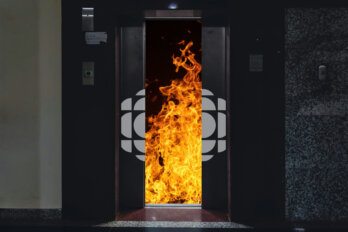Dear aspiring Indigenous journalists,
I share these words and sentiments with you, in the spirit of care and respect, as a former long-time journalist. You’re probably now second-guessing your career choice, if you haven’t already. A worldwide social movement to support Black lives has opportunely pushed systemic racism in all realms into focus, and that includes news media here in Canada. I’m sure this wasn’t a surprise to you because, as a person from the so-called margins, you’re well aware that racism thrives everywhere in this country. But the scope of racism at all levels of the journalism system—from the newsroom all the way up to executive offices—may have shocked you.
Before I urge you to stay with it, I can’t sugar-coat the hostile realities of working in mainstream Canadian journalism. You will feel alone. You will become very frustrated. You will want to give up. Many times. The dreams you once held for a long career of making change and doing stories that matter could very well evaporate.
People will pronounce your name incorrectly. They’ll mistake you for another Indigenous reporter. You’ll be asked by clueless colleagues to pronounce words and names in an Indigenous language different from yours. You may be pressured to soften the blow of Canada’s colonial history so as not to offend white audiences; as a result, the focus of your stories could shift from Indigenous people’s realities to white voices. You will be told this is for the sake of “balance.” The list of indignities you could experience as a rare Indigenous journalist in the newsroom goes on.
There’s a good chance you’ll be singled out just for being yourself. Everyone will know you as the Indigenous journalist. You may be the first Indigenous person they’ve ever met in their life, and you’ll have to go out of your way to be friendly to alleviate the fear of Natives that’s fuelled by stereotypes. I’m a big, brown, long-haired dude from the rez, and looking back, I’m ashamed of the times I stood down or aside to make others more comfortable.
Because you’re an outsider, your new colleagues may doubt your skills and merits and assume you arrived because of some sort of quota or special initiative. They’ll call your objectivity into question and doubt your capability to cover Indigenous-related stories just because of who you are. Paradoxically, they may not let you cover anything else. You’ll have to be extra nice and work even harder to erase those attitudes.
That’s because these spaces weren’t created for you. The stories they produce weren’t originally supposed to be about you or for you, either. And, in the rare past instances when your people did get mainstream coverage, it was usually to paint them as a tragedy or an obstacle: continuing the stereotypical “horrors” of reserve life or protesting and getting in the way of “good” Canadian taxpayers.
Most of the people in charge of journalism don’t look like you or other people of colour. They’re not familiar enough with people like you to make the industry a safe and comfortable place. And, a lot of the time, they’re totally unaware of what systemic racism is and how the essence of Canadian journalism has preserved it for decades. Those are just some of the barriers you’ll encounter internally.
Externally, the racism you’ll experience will be much more explicit and cutting. There’s a difference between subtle-yet-influential systemic racism and the overt slurs that flourish in the comments sections. Now that social media has opened up discussions about journalism to everyone and made reporters easily accessible, racists will thrive on diminishing you and your stories in attempts to uphold white supremacy. They’ll hound you, on online social platforms, about your appearance, your background, and the bias they perceive. The hateful words will come at you almost daily because they don’t want you there, helping people like you speak their truth and shattering the illusion of a benevolent Canada.
Sounds pretty terrible, right? I’ll peel back the curtain even further, but first, the most important thing for you to remember is that there is a wide community of past and present Indigenous journalists who support you and believe in you. I illustrate and share these challenges because I care. I care about you, and I still care about the industry and its potential. We all want you to succeed. And we want the industry to change for the better. It’s long overdue.
No matter what happens in your pursuit of a career in journalism, you’ll always have your community. That includes your home people and your circle of fellow Indigenous journalists. We’ll have your back, as those who came before us had ours. We may all come from different Indigenous nations and cultures on this land, but many of us share the essential responsibility of maintaining good relationships with one another and telling Indigenous stories properly and responsibly. That’s what kept me going for eighteen years.
I had a good career in journalism. I spent the bulk of it with Canada’s public broadcaster in major Canadian cities. Overall, it was a positive tenure that helped me grow as a storyteller, and I had many tremendous opportunities in a variety of platforms. I was a TV reporter for most of my time with the CBC, but I also got to host TV and radio programs, produce documentaries, write web features, and create meaningful journalism in general. I fulfilled my key objective of bringing Indigenous stories to the forefront and helping to provide a platform for the voices of everyday Indigenous people. I was also part of initiatives to improve internal awareness of Indigenous issues to foster better relationships with communities and do better journalism. I travelled to newsrooms within the CBC network to train non-Indigenous staff on how to better report on Indigenous issues and communities. The connections were significant.
Still, I left, and I don’t plan on returning to journalism in that way. I quit my job as a CBC Radio host in the spring to pursue other storytelling opportunities. Although it was the best job I ever had in mainstream Canadian media, the truth is, I never saw myself retiring as a journalist. I looked at the decades I had ahead of me and decided I wouldn’t be able to stick it out that long, even though I worked with mostly wonderful colleagues on a daily basis.
As you’re well aware, the foundation of Canadian media is whiteness. That means the default reader/viewer/listener perspective is that of a white Canadian. White people are traditionally the central characters in Canadian journalism, and every experience is measured against that. Legacy news organizations in this country were created by white people, for white people. And a strong sense of ego is at the core of many journalists’ ambitions, which likely conflicts with the inherent humility in storytelling prevalent in many Indigenous cultures, as you know. You’ll meet some reporters who are in it just for themselves and not for the people who’ve entrusted them with their stories.
So often, when you report, you’ll have to put on a white mask to appease gatekeepers and consumers. Sometimes that means keeping that mask on to explain your own people and history to the audience. That’s a result of the status quo that persisted for decades, until newsrooms started bringing in people from diverse backgrounds, one at a time. Those trail-blazing journalists of colour—including our own Indigenous aunties and uncles—fought hard for their jobs and their stories, and they held space for us to inhabit today. We’ll always be grateful for their efforts.
But Canadian journalism’s biggest structural problem is employing even fewer of those voices at the management and executive levels. Few of the reporters who broke the media colour barrier in Canada made it beyond the newsroom and into management. As such, the cycle of systemic racism perpetuates to the same degree today, manifesting itself in poor coverage, newsroom conflict, broken relationships, and short careers. I’ve seen many young Indigenous colleagues quit in frustration over these issues and leave mainstream journalism altogether.
Meanwhile, the entire industry binds itself to an archaic fallacy of neutrality that silences and limits journalists of colour.
And, when this happens, most of the editorial decision makers don’t even realize it. Recently, a would-be assassin crashed the gates at Rideau Hall, in Ottawa, only to be described by some news organizations as a “friendly sausage maker.” Meanwhile, Indigenous victims of violence aren’t afforded the same humanization. When Colten Boushie was killed on a Saskatchewan farm in 2016, the RCMP’s media release hinted at thefts in the area, shifting the blame to the victim, and news outlets echoed the police line. And, when you try to let victims or their families speak their truth, you could be accused of bias.
The whiteness default drives the journalistic objectivity that’s been idealized, and in this way, it further marginalizes perspectives outside of the dominant newsroom voice. You won’t feel like you can be yourself or like your background can add value to coverage or internal discussions.
Thankfully, news organizations are realizing their historic faults. This current societal shift has made many newsroom leaders introspective, and they’re making space in new ways for voices like yours. Major outlets like the Toronto Star have claimed a new commitment to measures to address inequality and discrimination.
I believe the future of Canadian journalism will be better for people like you. Your community is getting bigger and stronger. The gatekeepers are finally listening and appear willing to make meaningful structural and cultural change. But it is a shrinking industry overall, and deadlines and the next day’s coverage always take precedence. Those constant pressures could very well relegate these initiatives to fringe discussions and files, where so many other diversity and inclusion endeavours have gone to die. The inertia of white-centred journalism could easily continue to favour the status quo.
So speak your truth. Be yourself despite the traditional news structures that have long inhibited proper reflection. In the beginning, I was apprehensive to rock the boat because I knew of many trail-blazing Indigenous journalists who were chased from the industry just for trying to do what was right. But, once I became familiar with the rigid structures of Canadian media and the ways through and around them, I manoeuvred myself into a position with significant editorial freedom. I was treated with the respect that I was always taught to show others.
And, please, feel free to reach out to us. There are veteran Indigenous journalists on all beats, from politics to sports to music and so on. We’ve lived through it all, and thankfully, many of us remain in mainstream newsrooms, normalizing Indigenous voices and experiences. And reach out to your non-Indigenous colleagues too. Just don’t let anyone push you out.
Chi-miigwech,
Waubgeshig Rice
August 2020
Sudbury, Ontario





